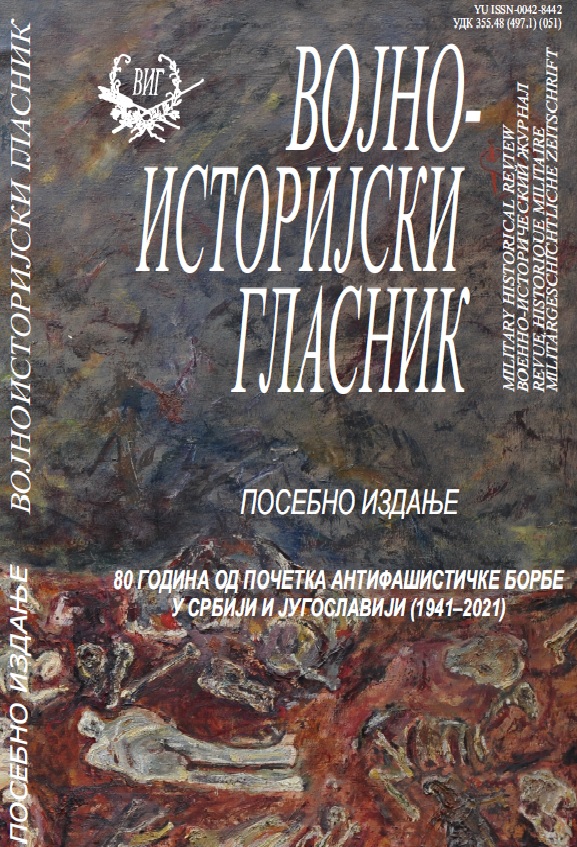ГУБИЦИ ПРИПАДНИКА ПАРТИЗАНСКОГ ПОКРЕТА ИЗ ЗАПАДНОГ ДЕЛА ОКУПИРАНЕ СРБИЈЕ У УСТАНКУ 1941. ГОДИНЕ
THE LOSSES OF MEMBERS OF THE PARTISAN MOVEMENT FROM THE WESTERN PART OF OCCUPIED SERBIA IN THE 1941 UPRISING
Author(s): Dragan CvetkovićSubject(s): History, Recent History (1900 till today), Special Historiographies:, WW II and following years (1940 - 1949), Fascism, Nazism and WW II
Published by: Institut za strategijska istraživanja
Keywords: Partisans / partisan movement; uprising; occupied Serbia; regions; population; Northwestern and part of Western Serbia; losses
Summary/Abstract: The geostatistical analysis of the losses of members of the partisan movement from the western parts of Serbia, who died in the uprising of 1941, was made on the basis of the partially revised census of ”Victims of the War 1941‐1945” from 1964. Dissatisfaction with the new situation, non‐ acceptance of the occupation, pronounced libertarian tradition manifested by a strong desire for freedom, geographical characteristics of the terrain suitable for guerrilla warfare, with propaganda and organizational work of the Communist Party on the ground, led to a nationwide uprising. Since the beginning of its existence and activities, the partisan movement in the western parts of Serbia has emerged as the best organized and the most militant part of the entire partisan movement in Serbia. The losses suffered in the uprising by members of the partisan movement from the region of Northwestern and parts of Western Serbia stood out from the beginning of the fighting in relation to the suffering of comrades from other parts of the occupied territory. There were differences in suffered losses within these two regions, as well as with other regions of occupied Serbia. Half of the losses of the partisan movement suffered in the uprising came from this part of the occupied territory (51.37%). Considering that 18.83% of the population lived in them, their loss was really 4.57 times higher than the loss of comrades from the other eight regions. Although these two regions had an almost equal share in losses, the real suffering of the partisans from a part of Western Serbia, given the population, was 1.75 times greater than the loss of their comrades from the region of Northwestern Serbia. The steady growth of the partisan losses from these two regions culminated in November when a third of the total losses suffered in 1941 was lost. Dominant in the movement’s losses since itsestablishment, partisans from Northwestern and parts of Western Serbia accounted for three‐fifths of the total number of partisans killed in occupied Serbia during September and November 1941 (57.19% and 55.12%, respectively). A quarter of all partisans killed in the region of Western Serbia (26.84%) lost their lives during 1941, which was 3.93 times more than the average loss in occupied Serbia that year. The total losses of the partisans of occupied Serbia who suffered in the uprising, given the periods of the existence and activities of the movement in them (six versus twelve months), were realistically 2.72 times higher than in the following year, but in the regions of Northwestern and Western Serbia they were 4.28 and 5.42 times higher, respectively. The uprising against the occupation, the establishment of a free territory, whose core was in the western parts of occupied Serbia, the struggle for its preservation, and also the struggle in the civil, revolutionary and ideological war with the monarchist movement, led to great losses of the partisan movement from this occupied territory. The scale of the suffering of the partisans from the Northwest and parts of Western Serbia clearly shows that these two regions suffered disproportionately greater losses in the fighting during the uprising and the initial phase of the civil war than their comrades from other parts of the occupied territory. The losses suffered in 1941 affected the weakening of the partisan movement in the next two years, but not to such an extent that it completely disappeared from this territory. During 1944, the partisan movement in these parts of occupied Serbia completely recovered, reorganized and strengthened, and became a signi‐ ficant part of the army that liberated Yugoslavia. Following the idea of freedom and the fighting path of the comrades from 1941, the movement emerged victorious from the war.
Journal: Vojnoistorijski glasnik
- Issue Year: 2022
- Issue No: poseban
- Page Range: 139-165
- Page Count: 27
- Language: Serbian

